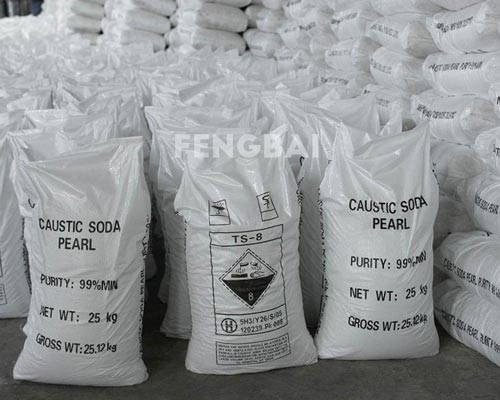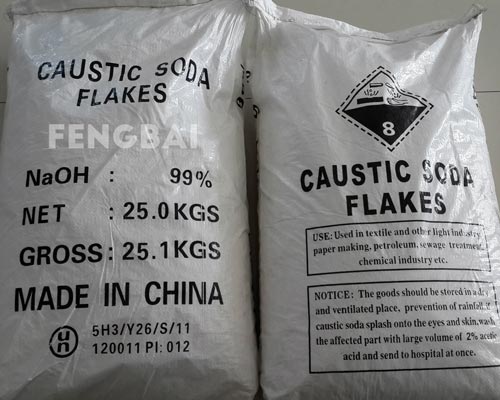- Product Name: Caustic Soda
- Appearance: Pearls/Flakes
- Sodium Hydroxide %≥: 99
- CAS No: 1310-73-2
- HS Code: 28151100
- Molecular Formula: NaOH
- Molecular Weight: 39.99707
Sodium hydroxide, commonly known as caustic soda, is an inorganic compound with the chemical formula NaOH. It appears as white, translucent crystals or solid blocks at room temperature. Common forms on the market include flakes, granules, blocks, and liquids. It is deliquescent and easily absorbs water vapor and carbon dioxide in the air, so we can add hydrochloric acid to check whether it has deteriorated. As an important basic chemical raw material, caustic soda can be commonly used in petroleum refining, pulp and paper production, textile processing, soap and detergent manufacturing, water treatment, and chemical raw material synthesis.
|
Items |
Caustic Soda Flakes |
Caustic Soda Pearls |
|
NaOH (Sodium Hydroxide) |
99% Min. |
99% Min. |
|
Na2CO3 (Sodium Carbonate) |
0.4% Max. |
0.3% Max. |
|
NaCl (Sodium Chloride) |
0.02% Max. |
0.02% Max. |
|
Fe2O3 (Ferric Oxide) |
0.005% Max. |
0.005% Max. |
|
Packing |
25KG PP bag 26 Ton per 20’FCL With pallet: 22 Ton per 20’FCL Any package according to buyer’s requirements. |
25KG PP bag 28Ton per 20’FCL With pallet: 25 Ton per 20’FCL Any package according to buyer’s requirements. |
|
Storage |
As a Class 8 corrosive substance, due to its corrosive nature, careful storage and safe production are required, eg protective equipment must be worn during handling and storage. Keep them in an airtight container in a dry warehouse. |
|
Main Applications of Caustic Soda 99% min
As an important inorganic compound, caustic soda for sale has many applications in different fields, for example, it is suitable for water treatment and softening, oil field drilling mud, petroleum product refining, sanitation, hygiene products. It can also be used as a raw material for the production of soaps, detergents, textiles and paper. In addition, it is also used as a pigment for acidity regulators, alkalis, impregnating agents.
- Adjusting acid-base balance. This chemical can be used as an acid-base indicator, which can neutralize many acidic substances and help adjust the acid-base balance. It is also a neutralizer for many acidic wastes.
- Cleaning agent. It is widely used for cleaning and removing dirt. It can be used to clean blockages in pipes, ovens and drainage systems. In addition, sodium hydroxide can also be used to remove grease and dirt from polar organic matter.
- Making soap. 99% caustic soda is also one of the indispensable raw materials for making soap. It reacts with grease or fatty acids to produce soap and glycerin.
- Papermaking. This product can be used for making paper and cellulose products. At the same time, caustic soda is also used to bleach pulp and remove impurities from wood fibers.
- Water treatment. Sodium hydroxide can be used to adjust the pH value of water to industrial or drinking water standards. It can neutralize acidic water and remove heavy metal ions from water.
- Food processing. Food grade caustic soda can be used as acid neutralizer in food industry, peeling agent for citrus, peaches, etc., as well as detergent for empty bottles and cans, as well as decolorizer and deodorizer.
- Chemical manufacturing. It is an important raw material for many chemicals, including sodium sulfate, caustic soda and sodium chlorate. These chemicals have a wide range of applications in industrial production, pharmaceuticals and agriculture.
Product Characteristics
- Strong Alkalinity. Caustic soda is a strong base that reacts vigorously with acids and exhibits powerful neutralization capability.
- High Reactivity. It readily absorbs moisture and carbon dioxide from the air, forming sodium carbonate. It reacts with many organic and inorganic substances and is widely used in chemical synthesis.
- Excellent Solubility. Highly soluble in water and releases a large amount of heat during dissolution; also soluble in ethanol and glycerin but insoluble in ether and other organic solvents.
- Corrosive Nature. Strongly corrosive to human tissue, especially the skin, eyes, and respiratory tract, as well as to aluminum, zinc, tin, and other non-ferrous metals.
- Stable Chemical Properties. Stable under normal storage conditions; non-volatile and non-flammable, but reacts with acids and certain metals to release hydrogen gas.
The caustic soda flakes appear as thin white flakes, produced by evaporating and pressing liquid caustic soda. While caustic soda pearls consist of small, uniform pellets or pearls, typically made by spray granulation.
Caustic soda flakes usually have a purity of 96–99% and are cost-effective, making them suitable for general industrial applications such as paper, textiles, electroplating, and wastewater treatment. While caustic soda pearls have higher purity (99% or above), better flowability, and dissolve more evenly, making them ideal for high-end applications like pharmaceuticals, food processing, specialty chemicals, and advanced water treatment.
The core difference comes from production-induced physical properties, which affect storage, handling, and market positioning. For example, caustic soda flakes prioritize low cost and high yield, while caustic soda pearls focus on purity and convenience. Choosing between the two forms should consider production needs, equipment, and budget to achieve the best match between the product form and application.
There are two main methods for industrial production of sodium hydroxide: causticizing and electrolysis.
- Causticizing. It is divided into soda ash causticizing and natural alkali causticizing according to the raw materials, and sodium hydroxide is produced through chemical reactions.
- The electrolysis method can be divided into diaphragm electrolysis and ion exchange membrane method. By electrolyzing saturated salt water solution, chlorine is generated on the anode and sodium hydroxide solution is generated on the cathode.
- Protective Measures: Wear alkali-resistant gloves, safety goggles, and protective clothing during handling to avoid direct contact with skin and eyes. In case of accidental contact, immediately rinse with plenty of running water (flush skin for at least 15 minutes and eyes for at least 20 minutes) and seek medical attention promptly.
- Storage Requirements: Store in a tightly sealed container in a dry, cool, and well-ventilated area. Keep away from acids, metal powders, and organic materials (such as paper or cotton). Avoid exposure to air to prevent deliquescence or absorption of carbon dioxide, which may cause deterioration (formation of sodium carbonate).
- Dissolution Guidelines: When dissolving solid caustic soda, slowly add the caustic soda to water (never add water to caustic soda, as the intense heat released can cause splashing) and stir continuously to dissipate heat and avoid excessive local temperatures.
Febgbai - A Leading Caustic Soda Manufacturer & Supplier
- A leading caustic soda manufacturer & supplier in China, Fengbai company has more than 15+ years’ experience in chemical industry.
- Fengbai has its own factory, raw materials and large warehouse.
- We have sufficient goods, so we can guarantee timely delivery.
- We always provide high quality caustic soda products and competitive prices for all the clients.
- All of our products have stringent quality certifications, such as ISO9001:2015, SGS, HACCP, KOSHER, HALAL, etc.
- Our products have been exported to more than 30 countries, including Pakistan, Korea, Thailand, Vietnam, Malaysia, Singapore, Vietnam, Indonesia, Iran, Chile, Brazil, UAE, Saudi Arabia, Uzbekistan, Turkey, Mexico, Colombia, Bahrain, Israel, etc.


